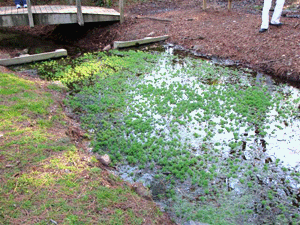Difference between revisions of "Herbicides used to Control Parrotfeather"
From Wiki
| Line 1: | Line 1: | ||
Parrotfeather control can be difficult to achieve since the leaves and stems are protected by a heavy layer of waxy cuticle which must be softened or stripped utilizing a wetting agent such as CideKick II or comparable wetting agent.[[image:parrotfeather.jpg | right | Parrotfeather infestation in a small stream]] | Parrotfeather control can be difficult to achieve since the leaves and stems are protected by a heavy layer of waxy cuticle which must be softened or stripped utilizing a wetting agent such as CideKick II or comparable wetting agent.[[image:parrotfeather.jpg | right | Parrotfeather infestation in a small stream]] | ||
| − | Several registered herbicidal ingredients such as diquat, endothol, 2,4-D and glyphosate, imazapyr and triclopyr have been effective. Granular products such as Navigate are effective in moving water or where extended control is desired. | + | Several registered herbicidal ingredients such as diquat, endothol, 2,4-D and glyphosate, imazapyr and triclopyr have been effective. Granular products such as Navigate are effective in moving water or where extended control is desired. [[image:parrotfeathers.jpg | right | Parrotfeather infestation in a small stream]] |
